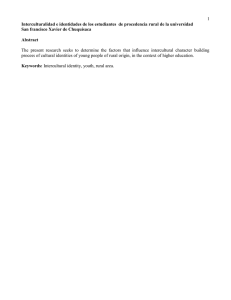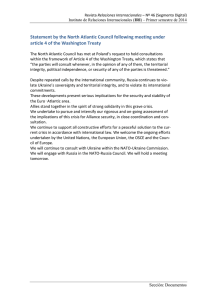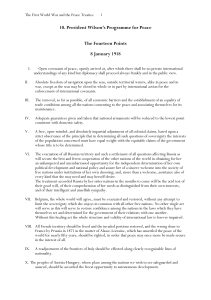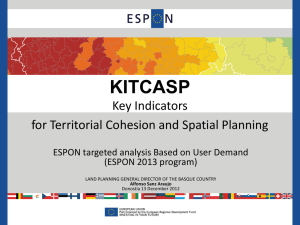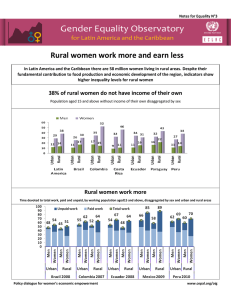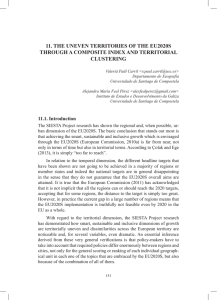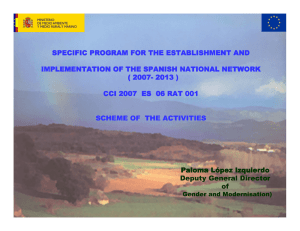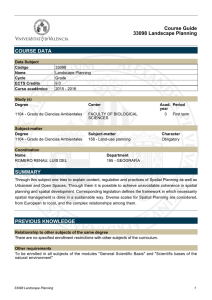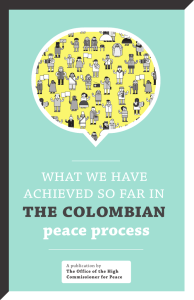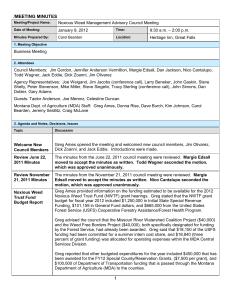Sustainable development and the territorial approach
Anuncio
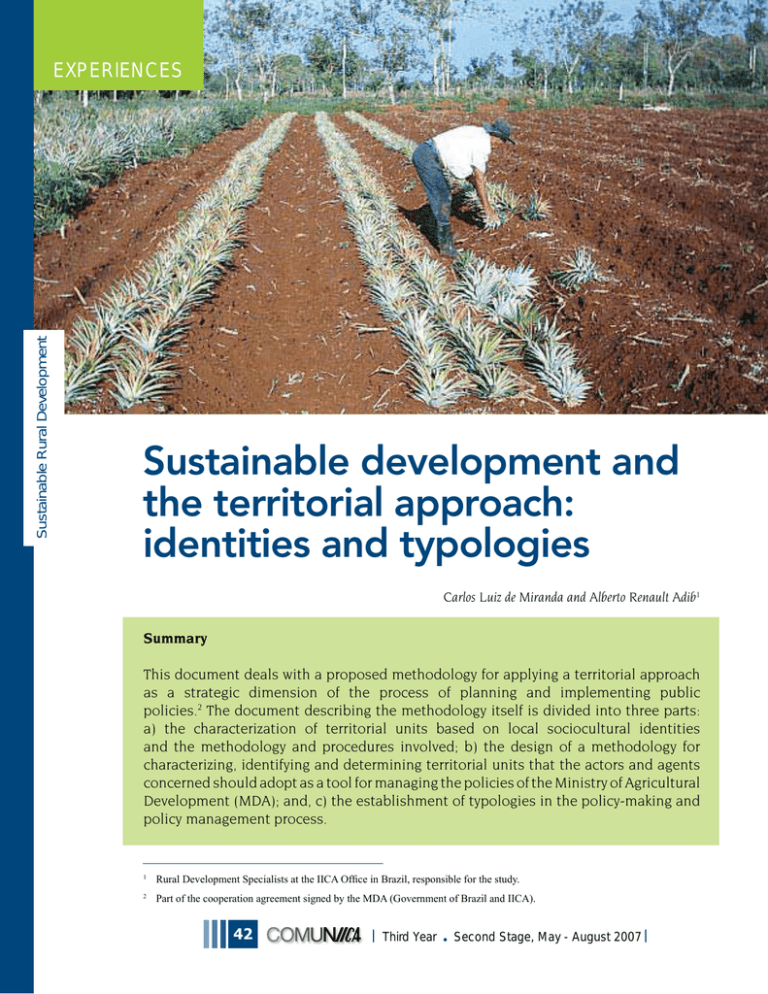
Sustainable Rural Development EXPERIENCES Sustainable development and the territorial approach: identities and typologies Carlos Luiz de Miranda and Alberto Renault Adib1 Summary This document deals with a proposed methodology for applying a territorial approach as a strategic dimension of the process of planning and implementing public policies.2 The document describing the methodology itself is divided into three parts: a) the characterization of territorial units based on local sociocultural identities and the methodology and procedures involved; b) the design of a methodology for characterizing, identifying and determining territorial units that the actors and agents concerned should adopt as a tool for managing the policies of the Ministry of Agricultural Development (MDA); and, c) the establishment of typologies in the policy-making and policy management process. 1 Rural Development Specialists at the IICA Office in Brazil, responsible for the study. 2 Part of the cooperation agreement signed by the MDA (Government of Brazil and IICA). 42 Third Year Second Stage, May - August 2007 Key words: rural development, sustainability, territorial identities, public policies Introduction The aim of this article is to publicize the study Sustainable development and the territorial approach: identities and typologies. Hopefully, the methodology it describes will be applicable to other countries and territories in Latin America, and thereby serve as a contribution by IICA to the management of knowledge related to rural development in the hemisphere. The territorial approach is a new concept in which rural development is viewed not only in terms of its physical and sectoral dimensions, but also as a locus where the interaction of a set of social relationships creates and gives expression to an identity and to society’s capacity to lead and manage its own development. In making the transition from a “sectoral” and “local” approach to a “territorial” approach, public institutions have to decide whether to use territories for their own purposes or accept that the territorial approach should be primarily endogenous in nature, taking into account the identity of the territory concerned. Therefore, territories should not be defined simply in terms of the State’s need to execute public policies. The concept of territorial identity can be regarded, then, as the collective recognition of an intricate meshing of characteristics and components specific to a given social fabric, unique to the inhabitants of a spatial unit and determined by its particular Third Year resources and the environmental, politicalinstitutional, economic and sociocultural dimensions. As a strategy for public policies, typologies based on territorial identity make it possible, based on the convergence of interests of the social actors and public agents, to objectively orient sustainable rural development actions in a given space. The work was coordinated by IICA and the Permanent Forum on Sustainable Rural Development (SRD Forum at the request of the National Sustainable Rural Development Council (CONDRAF), to support the implementation of the territorial approach in the The concept of territorial sphere of activity of the identity can be regarded, Territorial Development Secretariat (SDT) of the then, as the collective Ministry of Agricultural recognition of an intricate meshing of characteristics Development (MDA). The study was carried out in three stages between January 2006 and February 2007. and components specific to a given social fabric, unique to the inhabitants of a spatial unit and determined by its particular resources and the environmental, politicalinstitutional, economic and sociocultural dimensions. 1. Stage One. Established a conceptual framework and outlined the application of the approach by the country’s governmental sector, and incorporated Second Stage, May - August 2007 43 geo-environmental and institutional relationships that create, and at the same time are a manifestation of, an identity and a purpose shared by social actors and multiple public and private agents. information about the experience of certain Latin American countries. 2. Stage Two. Based on the analysis of information from the territories defined by the SDT/MDA and secondary sources, it established the methodological underpinnings. 3. Stage Three. Consisted of statistical analyses of secondary sources and the results of field research. After identifying the main differentiating characteristics of rural territories, the experts were able to construct the territorial characterization model. The following is a description of the conceptual framework and methodological process adopted by IICA/Brazil for the work. Public institutions have to decide whether to use territories for their own purposes or accept that the territorial approach should be primarily endogenous in nature, taking into account the identity of the territory concerned. 44 Conceptual framework The territorial approach, as a social construct, entails a set of historicalcultural, economic, Third Year Multisectoral budgets for the rural milieu should focus on rural areas from a spatial rather than a sectoral perspective. There is strong evidence that (agricultural and non-agricultural) rural households engage in a variety of economic activities, even in the least developed regions. Therefore, the units of analysis should not be limited to agricultural or food systems, nor to specific social categories. In other words, rural development should be seen from the spatial, multifunctional and multisectoral standpoint, and agriculture as a part of it. Basically, multifunctionality is the term used to describe how agriculture performs other functions besides the production of food and fibers. Those functions include rural employment, the occupation of space, the equilibrium of small cities, the preservation of the environment and the landscape, and respect for local culture. The multidimensional nature of the territorial approach cannot be regarded simply as the sum of the components of a given territory. Development is neither relative nor heterogeneous; first and foremost, it is in cultural in nature. The economy is a manifestation of the culture, wellbeing is a manifestation of the culture and the social relationships are a manifestation of the culture. Therefore, the culture is the result of the territory’s Second Stage, May - August 2007 multidimensional nature and of the interrelationships among the different dimensions, and is the key to defining the territory as a concept. Defining typology models based on the territorial identity for use in public policies gives meaning and content to sustainable rural development actions in an objectively determined space, based on the convergence of interests of the social actors and government agents. In this regard, it is essential to find ways of incorporating the identity, culture and territorial concept into development models; failure to do so undermines the capacity of public policies to respond to the special features inherent in the diversity of rural territories. Methodological process 1. Review of public, federal and state policies and actions targeted at territories or that have an effect on territories. 2. Theoretical-conceptual analysis and definition of the operating frameworks for constructing the model of territorial typologies. 3. Construction of the database, using statistical information with three levels of analysis: municipalities, micro-regions and territories. These underpinnings will provide the information for the analyses of regionalization and territorial characterization. 4. Analysis of the regional characteristics of the country’s micro-regions. 5. Systematization of the process of constructing the “territories with specific identities,” based on the political decisions taken by the set of actors and agents taking part in the process. Third Year Second Stage, May - August 2007 In this regard, it is essential to find ways of incorporating the identity, culture and territorial concept into development models; failure to do so undermines the capacity of public policies to respond to the special features inherent in the diversity of rural territories. 45 6. First outline of a general model of territorial typologies. 7. Analysis of the process of targeting and selecting territories carried out by the SDT/MDA and construction of the first typology applied to the process of constructing the “territories with specific identities.” 8. Analysis of the differences found between the selection made by the SDT/MDA and the “territories with specific identities” defined as part of the operating strategy of this effort. 9. Design of the model of territorial typologies and definition of its components and of the variables and indicators of which it is composed. Impact on the management of territories Result of the work The work produced a methodology for using the territorial approach in planning and implementing public rural development policies. In the case of Brazil, the use of the methodology led to the construction of a model of a typology for “territories with specific identities” classified according to the level of incidence (high, medium or low) of the following dimensions: a) Socio-environmental b) Socio-economic c) Socio-cultural d) Socio-political and institutional In designing the model, the consultants also took into account the key factors that Development objectives and impacts Critical mass for management capacity Identity Development thresholds Feature of cohesiveness for collective action Figure 1. Processes and relationships for constructing the dimensions of territories with specific identities. Source: IICA-MDA 2006. 46 Third Year Second Stage, May - August 2007 differentiated the territories. In doing so, they established three basic sources of criteria for the heterogeneity of the “territories with specific identities,” which had to do with the management capacity, development portals and the characteristics of cohesiveness for collective action, as shown in the Figure 1. The most important lesson learned in the process of formulating the typology model is that it allows public managers to formulate policies and define local investments, adopting an endogenous development planning approach that takes advantage of the potential of territories while respecting their specific characteristics. Furthermore, this model of territorial typologies, based on the identities of the territories concerned, provides the basis for formulating and operating territorially differentiated public policies, a key strategic element in Brazil (a country that is very heterogeneous at the regional and subregional levels) for the sustainability of its rural development policies. Bibliographic references IICA (Inter-American Institute for Cooperation on Agriculture); MDA (Ministry of Agricultural Development). 2006. Desenvolvimento Sustentável e Territorialidade: identidades e tipologias, Bases conceituais e proposta metodológica, Brasilia, BR. ______. Desenvolvimento Sustentável e Territorialidade: identidades e tipologias, Report on Stage II, Brasilia, BR. ______. Desenvolvimento Sustentável e Territorialidade: identidades e tipologias, Final Report, Brasilia, BR. MDA (Ministry of Agricultural Development). 2004. Programa Nacional de Desenvolvimento Sustentável de Territórios Rurais: referência para o apoio ao desenvolvimento territorial. Brasilia, BR. Although this is a Brazilian initiative, it is hoped that the methodology can be adapted and reproduced in others countries of the region. Third Year Second Stage, May - August 2007 47 Résumé / Resumo / Resumen Développement durable et territorialité : identité et typologies L e document présente une proposition méthodologique pour l’utilisation d’une approche territoriale, en tant que dimension stratégique, lors de la planification et de la mise en application des politiques publiques. Le contenu de la proposition originale est divisé en trois parties : a) la typification des unités territoriales à partir des identités sociales et culturelles locales, la méthodologie et les procédures ; b) la conception d’une méthodologie pour la caractérisation, l’identification et la délimitation des unités territoriales, lesquelles devront être acceptées par leurs acteurs et agents comme un instrument de gestion des politiques du ministère du développement agricole du Brasil; et c) l’établissement des typologies dans la formulation et la gestion des politiques. Desenvolvimento sustentável e territorialidade: identidades e tipologias E ste documento trata de uma proposta metodológica para aplicação do enfoque territorial como dimensão estratégica no planejamento e implementação das políticas públicas. A proposta original divide-se em três partes: (a) tipificação das unidades territoriais com base nas identidades socioculturais locais, metodologia e procedimentos: (b) delineamento de uma metodologia para a caracterização, identificação e delimitação das unidades territoriais que deverão ser reconhecidas por seus atores e agentes como instrumentos de gestão das políticas do Ministério do Desenvolvimento Agrário (MDA) do Brasil; e (c) estabelecimento das tipologias na formulação e gestão da política. Desarrollo sostenible y territorialidad: identidades y tipologías E l documento refiere a una propuesta metodológica para la aplicación de un abordaje territorial como dimensión estratégica en el planeamiento y la implementación de las políticas públicas2. El contenido de la propuesta original está dividido en tres partes: a) tipificación de las unidades territoriales con base en las identidades socioculturales locales, metodología y procedimientos; b) diseño de una metodología para la caracterización, identificación y delimitación de las unidades territoriales que deberán ser reconocidas por sus actores y agentes como instrumento de gestión de las políticas del Ministerio de Desarrollo Agrario (MDA) de Brasil; y c) establecimiento de las tipologías en la formulación y la gestión de la política. 48 Third Year Second Stage, May - August 2007
